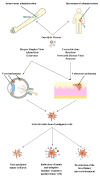New Treatment Horizons in Uveal and Cutaneous Melanoma
- PMID: 37629523
- PMCID: PMC10455832
- DOI: 10.3390/life13081666
New Treatment Horizons in Uveal and Cutaneous Melanoma
Abstract
Melanoma is a complex and heterogeneous malignant tumor with distinct genetic characteristics and therapeutic challenges in both cutaneous melanoma (CM) and uveal melanoma (UM). This review explores the underlying molecular features and genetic alterations in these melanoma subtypes, highlighting the importance of employing specific model systems tailored to their unique profiles for the development of targeted therapies. Over the past decade, significant progress has been made in unraveling the molecular and genetic characteristics of CM and UM, leading to notable advancements in treatment options. Genetic mutations in the mitogen-activated protein kinase (MAPK) pathway drive CM, while UM is characterized by mutations in genes like GNAQ, GNA11, BAP1, EIF1AX, and SF3B1. Chromosomal aberrations, including monosomy 3 in UM and monosomy 10 in CM, play significant roles in tumorigenesis. Immune cell infiltration differs between CM and UM, impacting prognosis. Therapeutic advancements targeting these genetic alterations, including oncolytic viruses and immunotherapies, have shown promise in preclinical and clinical studies. Oncolytic viruses selectively infect malignant cells, inducing oncolysis and activating antitumor immune responses. Talimogene laherparepvec (T-VEC) is an FDA-approved oncolytic virus for CM treatment, and other oncolytic viruses, such as coxsackieviruses and HF-10, are being investigated. Furthermore, combining oncolytic viruses with immunotherapies, such as CAR-T cell therapy, holds great potential. Understanding the intrinsic molecular features of melanoma and their role in shaping novel therapeutic approaches provides insights into targeted interventions and paves the way for more effective treatments for CM and UM.
Keywords: chromosome aberrations; cutaneous melanoma; genetic mutations; metastatic melanoma; uveal melanoma.
Conflict of interest statement
The authors declare no conflict of interest.
Figures

Similar articles
-
Recent Advances in Molecular and Genetic Research on Uveal Melanoma.Cells. 2024 Jun 12;13(12):1023. doi: 10.3390/cells13121023. Cells. 2024. PMID: 38920653 Free PMC article. Review.
-
Chromosome 3 status combined with BAP1 and EIF1AX mutation profiles are associated with metastasis in uveal melanoma.Invest Ophthalmol Vis Sci. 2014 Jun 26;55(8):5160-7. doi: 10.1167/iovs.14-14550. Invest Ophthalmol Vis Sci. 2014. PMID: 24970262
-
Prognostic value of chromosomal imbalances, gene mutations, and BAP1 expression in uveal melanoma.Genes Chromosomes Cancer. 2018 Aug;57(8):387-400. doi: 10.1002/gcc.22541. Genes Chromosomes Cancer. 2018. PMID: 29689622
-
GNAQ and GNA11 mutant nonuveal melanoma: a subtype distinct from both cutaneous and uveal melanoma.Br J Dermatol. 2020 Nov;183(5):928-939. doi: 10.1111/bjd.18947. Epub 2020 Apr 13. Br J Dermatol. 2020. PMID: 32064597
-
Recent Advances and Challenges in Uveal Melanoma Immunotherapy.Cancers (Basel). 2022 Jun 23;14(13):3094. doi: 10.3390/cancers14133094. Cancers (Basel). 2022. PMID: 35804863 Free PMC article. Review.
Cited by
-
Uveal Melanoma: Comprehensive Review of Its Pathophysiology, Diagnosis, Treatment, and Future Perspectives.Biomedicines. 2024 Aug 5;12(8):1758. doi: 10.3390/biomedicines12081758. Biomedicines. 2024. PMID: 39200222 Free PMC article. Review.
-
Biological characteristics and clinical management of uveal and conjunctival melanoma.Oncol Res. 2024 Jul 17;32(8):1265-1285. doi: 10.32604/or.2024.048437. eCollection 2024. Oncol Res. 2024. PMID: 39055896 Free PMC article. Review.
-
Integrating Single-cell and Bulk RNA-seq to Construct a Metastasis-related Model for Evaluating Immunotherapy and Chemotherapy in Uveal Melanoma.Curr Med Chem. 2024;31(42):7030-7042. doi: 10.2174/0109298673286355231222054226. Curr Med Chem. 2024. PMID: 38173196
-
Recent Advances in Molecular and Genetic Research on Uveal Melanoma.Cells. 2024 Jun 12;13(12):1023. doi: 10.3390/cells13121023. Cells. 2024. PMID: 38920653 Free PMC article. Review.
References
-
- Spathis A., Katoulis A., Damaskou V., Liakou A., Kottaridi C., Leventakou D., Sgouros D., Mamantopoulos A., Rigopoulos D., Karakitsos P., et al. BRAF mutation status in primary, recurrent, and metastatic malignant melanoma and its relation to histopathological parameters. Dermatol. Pract. Concept. 2019;9:54–62. doi: 10.5826/dpc.0901a13. - DOI - PMC - PubMed
-
- Heppt M.V., Siepmann T., Engel J., Schubert-Fritschle G., Eckel R., Mirlach L., Kirchner T., Jung A., Gesierich A., Ruzicka T., et al. Prognostic significance of BRAF and NRAS mutations in melanoma: A German study from routine care. BMC Cancer. 2017;17:536. doi: 10.1186/s12885-017-3529-5. - DOI - PMC - PubMed
Publication types
LinkOut - more resources
Full Text Sources
Research Materials
Miscellaneous

